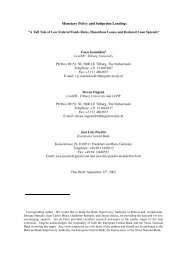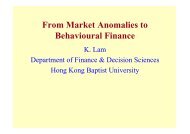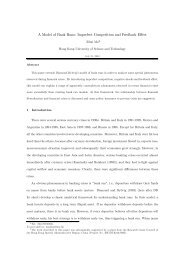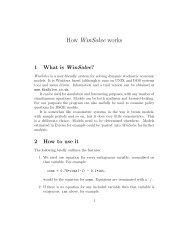Macroeconomics of the Franco-Prussian War Indemnity
Macroeconomics of the Franco-Prussian War Indemnity
Macroeconomics of the Franco-Prussian War Indemnity
You also want an ePaper? Increase the reach of your titles
YUMPU automatically turns print PDFs into web optimized ePapers that Google loves.
Hong Kong Institute for Monetary Research<br />
where q xt = 1/φ ′ (i xt /k xt ) is <strong>the</strong> real price <strong>of</strong> a unit <strong>of</strong> capital in <strong>the</strong> export sector, in terms <strong>of</strong> <strong>the</strong><br />
composite good, and r xt+1 is <strong>the</strong> rental rate on capital in <strong>the</strong> export sector. A similar relationship holds<br />
in <strong>the</strong> non-traded sector, with relative price q Nt .<br />
Firms face a static optimization problem, and simply maximize pr<strong>of</strong>its. Production functions are Cobb-<br />
Douglas, with exponent α in <strong>the</strong> export sector and κ in <strong>the</strong> non-traded sector. The pr<strong>of</strong>it-maximizing<br />
conditions for <strong>the</strong> two sectors are:<br />
r xt = αk α−1<br />
xt h 1−α<br />
xt<br />
w t = (1 − α)k α xt h−α xt<br />
r Nt = p Nt κk κ−1<br />
(23)<br />
Nt h1−κ Nt<br />
w t = p Nt (1 − κ)k α Nt h−κ Nt .<br />
For simplicity, we assume that <strong>the</strong> government finances a transfer and government spending with a<br />
lump-sum tax. Its budget constraint is:<br />
p t g t + T t = p t τ t . (24)<br />
The implicit assumption here is that government spending falls across sectors in <strong>the</strong> same proportion<br />
as private spending. The dynamic effects <strong>of</strong> <strong>the</strong> war and transfer in this model would be affected by <strong>the</strong><br />
pattern <strong>of</strong> distorting taxes used to finance <strong>the</strong>m. However, we lack detailed data on <strong>the</strong> government’s<br />
revenues which would allow us to study <strong>the</strong> effects <strong>of</strong> <strong>the</strong> financing plan, along <strong>the</strong> lines originated by<br />
Ohanian (1997) for <strong>the</strong> twentieth-century U.S.<br />
Following recent, numerical methods in open economy macroeconomics, developed by Schmitt-Grohé<br />
and Uribe (2003) and Kollmann (2002), we assume that <strong>the</strong>re is a debt-elastic differential between <strong>the</strong><br />
home and foreign rates <strong>of</strong> interest. Thus, denoting <strong>the</strong> foreign rate <strong>of</strong> return (in terms <strong>of</strong> good x) as rt ∗ ,<br />
and French net foreign assets by b t , <strong>the</strong> relationship between French and world interest rates is given<br />
by<br />
(1 + r t+1 ) = (1 + r ∗ t+1 )ψ(b t+1 − ¯b) (25)<br />
where <strong>the</strong> function ψ(b t+1 − ¯b) satisfies ψ (0) = 1, and ψ ′ < 0. This function captures <strong>the</strong> idea <strong>of</strong> an<br />
upward-sloping supply curve <strong>of</strong> foreign credit. When <strong>the</strong> economy is a net borrower, it faces an interest<br />
rate that is higher than <strong>the</strong> interest rate <strong>of</strong> its trading partner. When it is a lender, it receives an interest<br />
rate that is lower than that <strong>of</strong> <strong>the</strong> o<strong>the</strong>r country. This specification plays two roles. First, from a technical<br />
viewpoint, it eliminates <strong>the</strong> presence <strong>of</strong> a unit root in <strong>the</strong> world wealth distribution, because ¯b represents<br />
a steady-state level <strong>of</strong> net foreign assets for <strong>the</strong> home country. Second, it captures <strong>the</strong> presence <strong>of</strong><br />
‘frictions’ in <strong>the</strong> international capital markets. As <strong>the</strong>se frictions become larger and larger, captured by a<br />
larger absolute value <strong>of</strong> ψ ′ , <strong>the</strong> effect <strong>of</strong> <strong>the</strong> transfer is more and more contained within <strong>the</strong> period <strong>of</strong><br />
<strong>the</strong> transfer, and <strong>the</strong> use <strong>of</strong> international capital markets to smooth out <strong>the</strong> impact <strong>of</strong> <strong>the</strong> transfer is<br />
reduced. As Schmitt-Grohé and Uribe (2003) show, this friction has an effect on <strong>the</strong> response <strong>of</strong> an<br />
11








